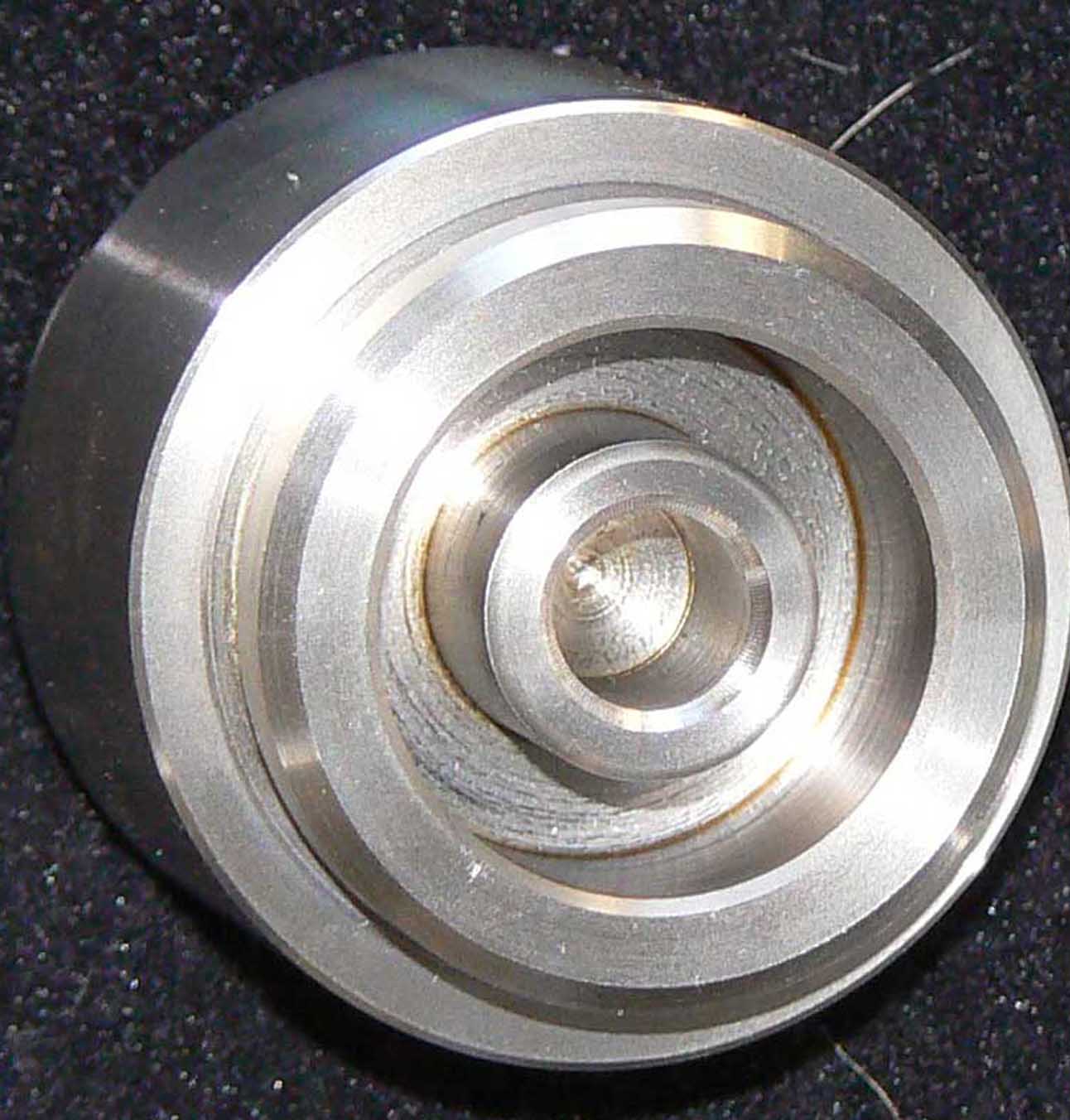
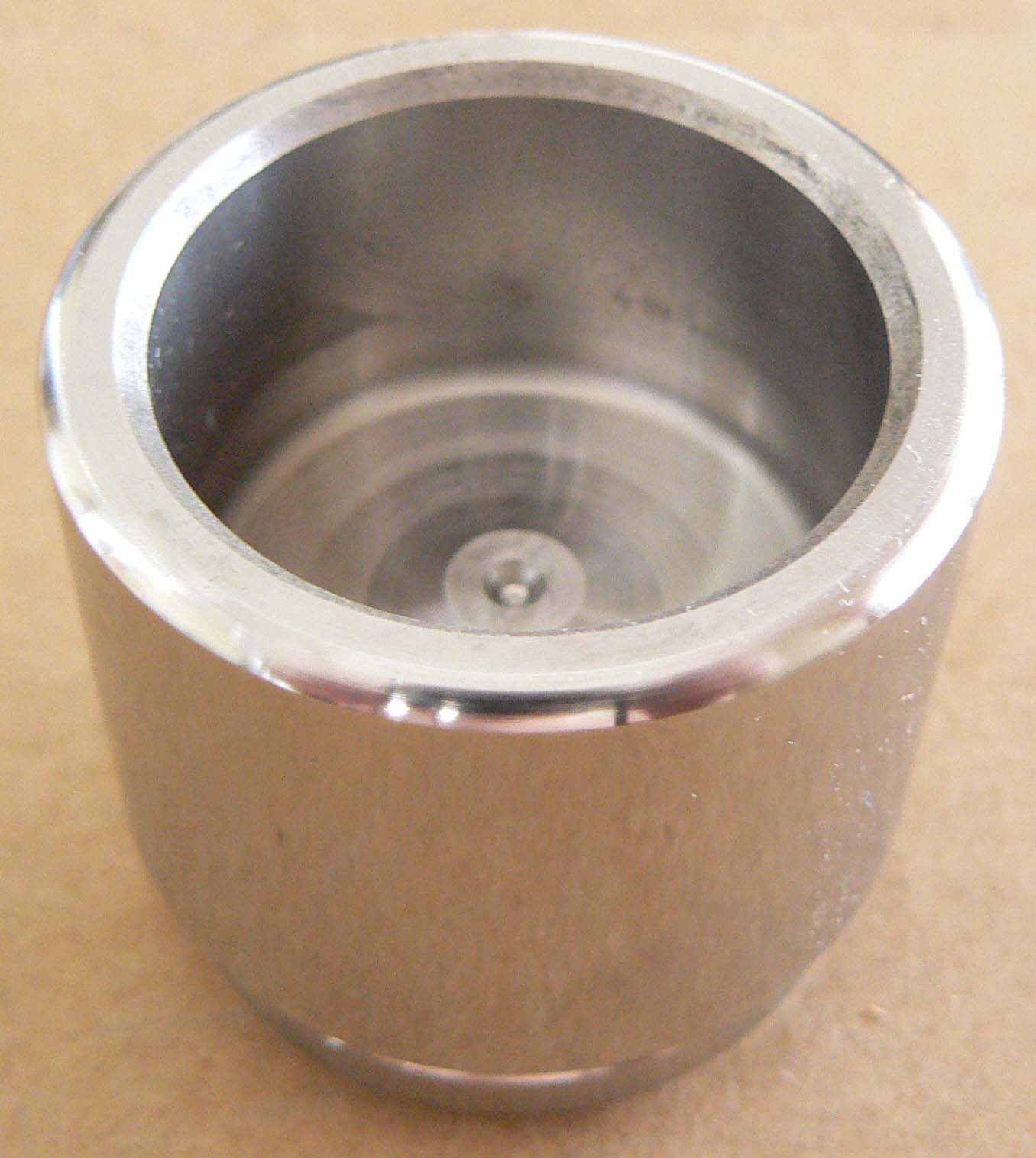
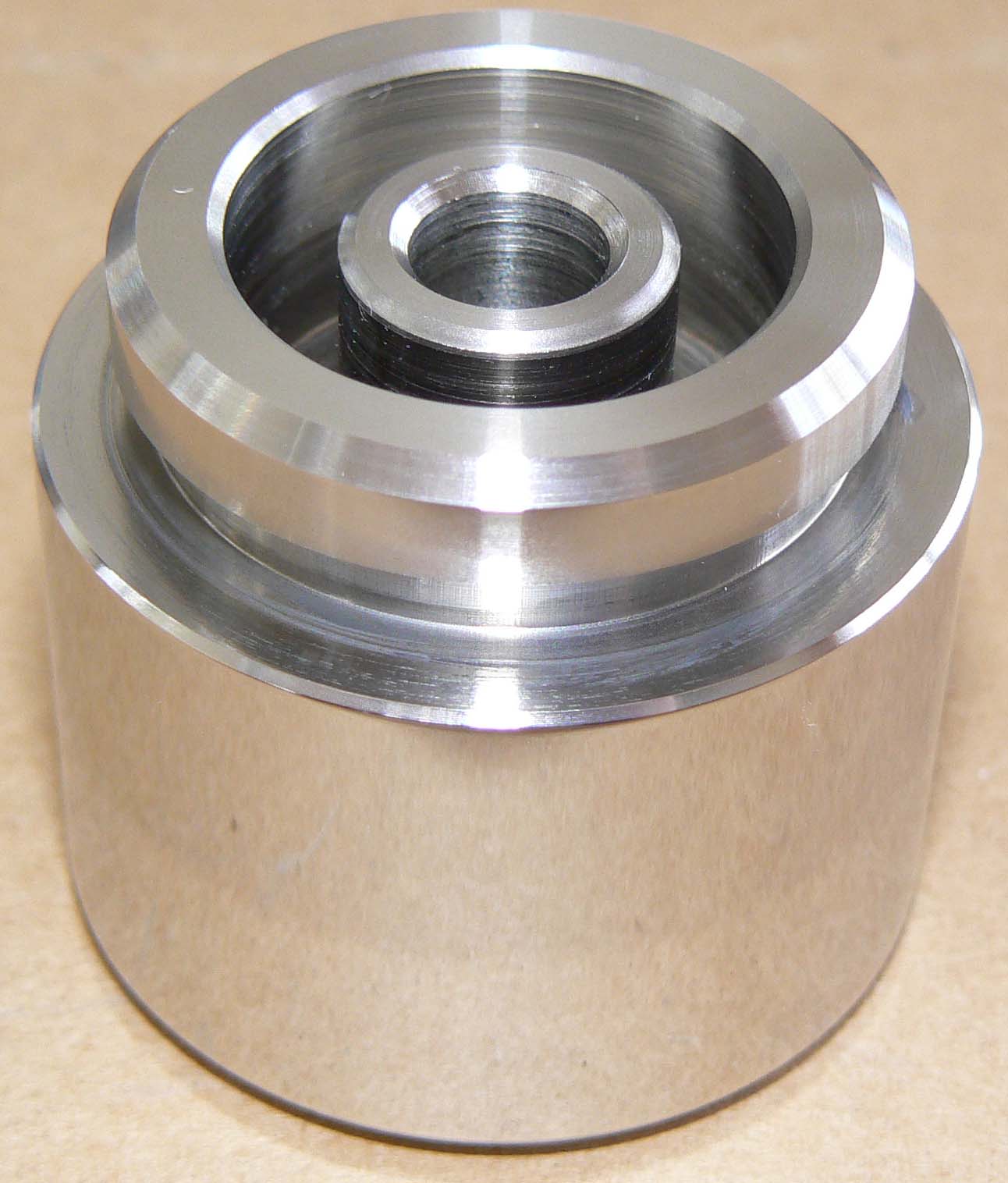
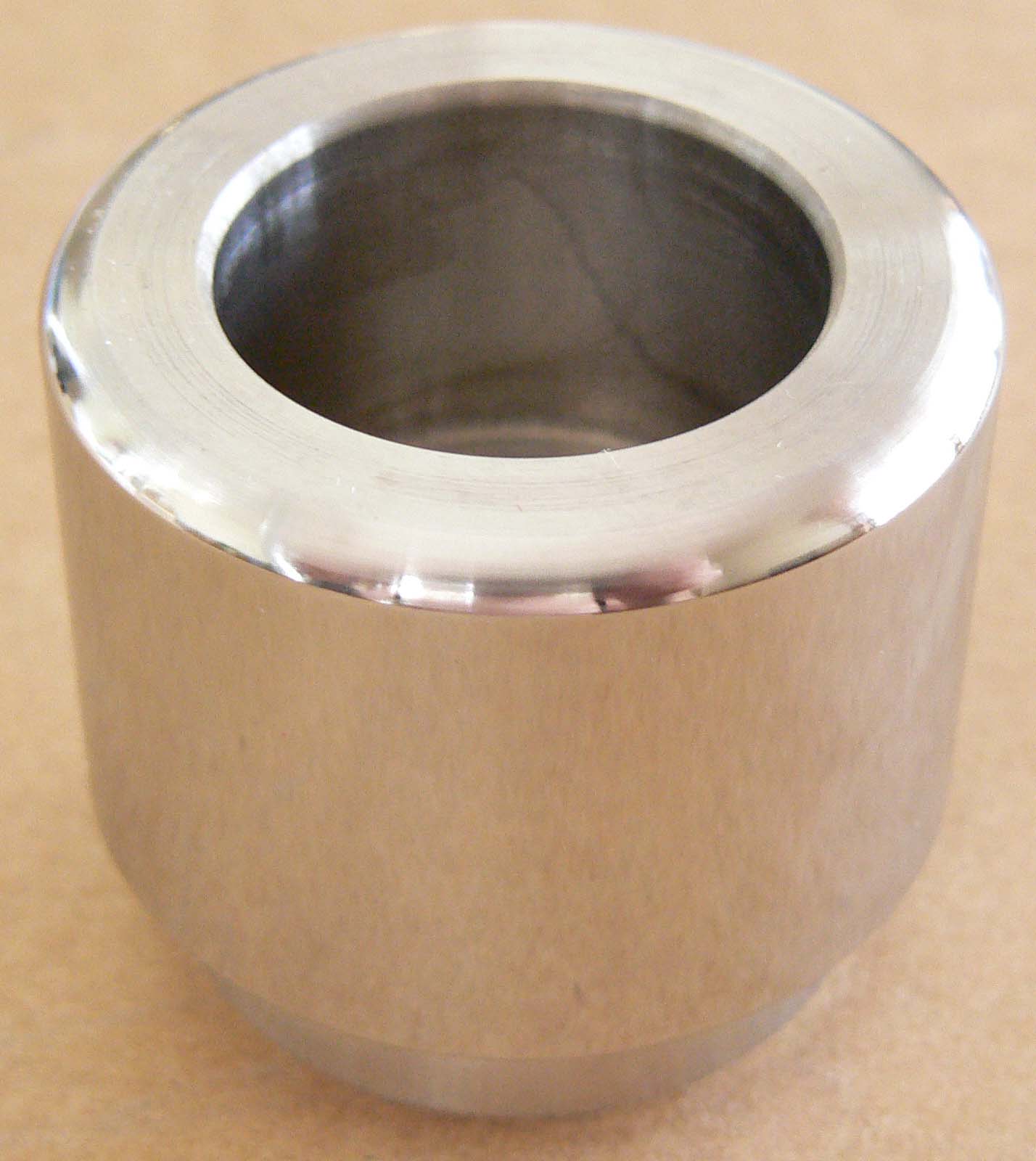
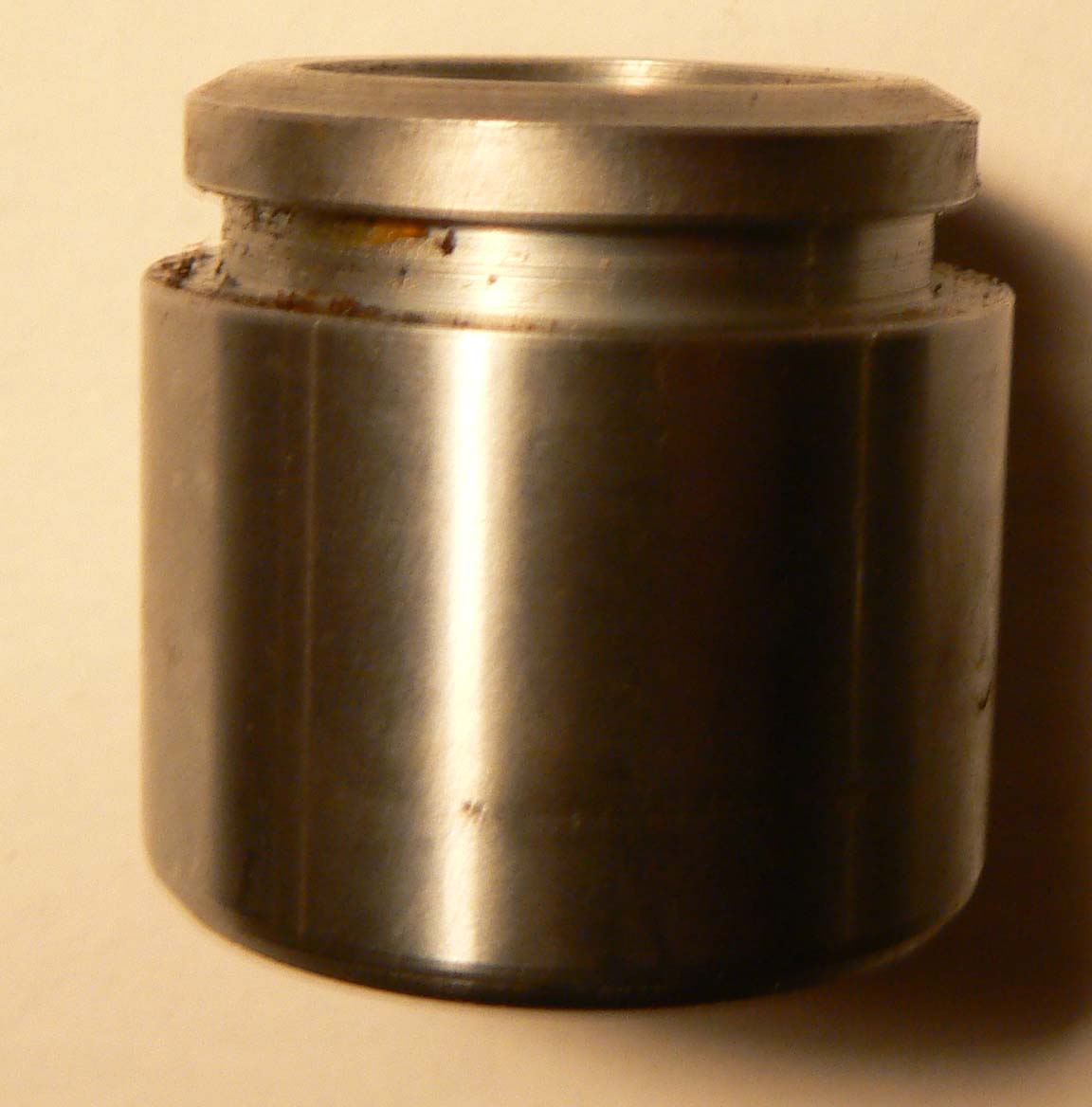
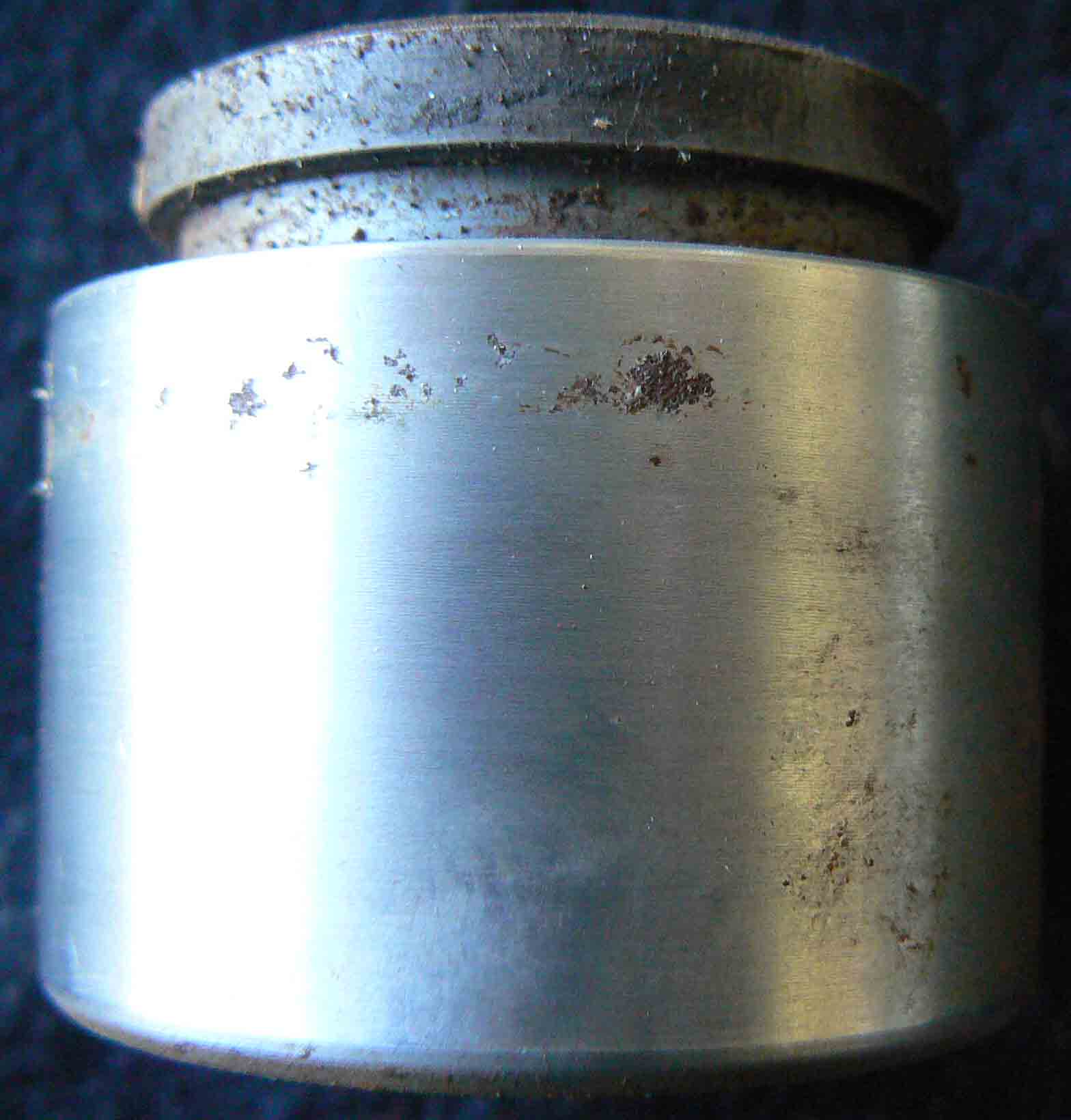
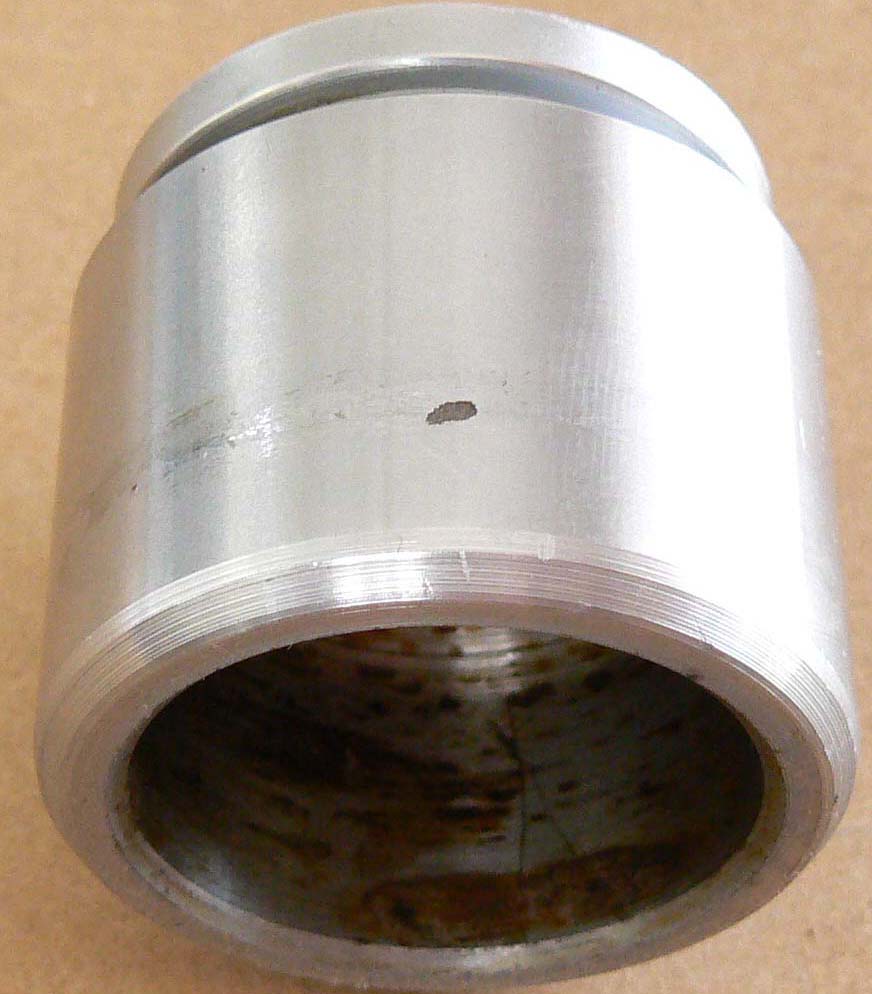
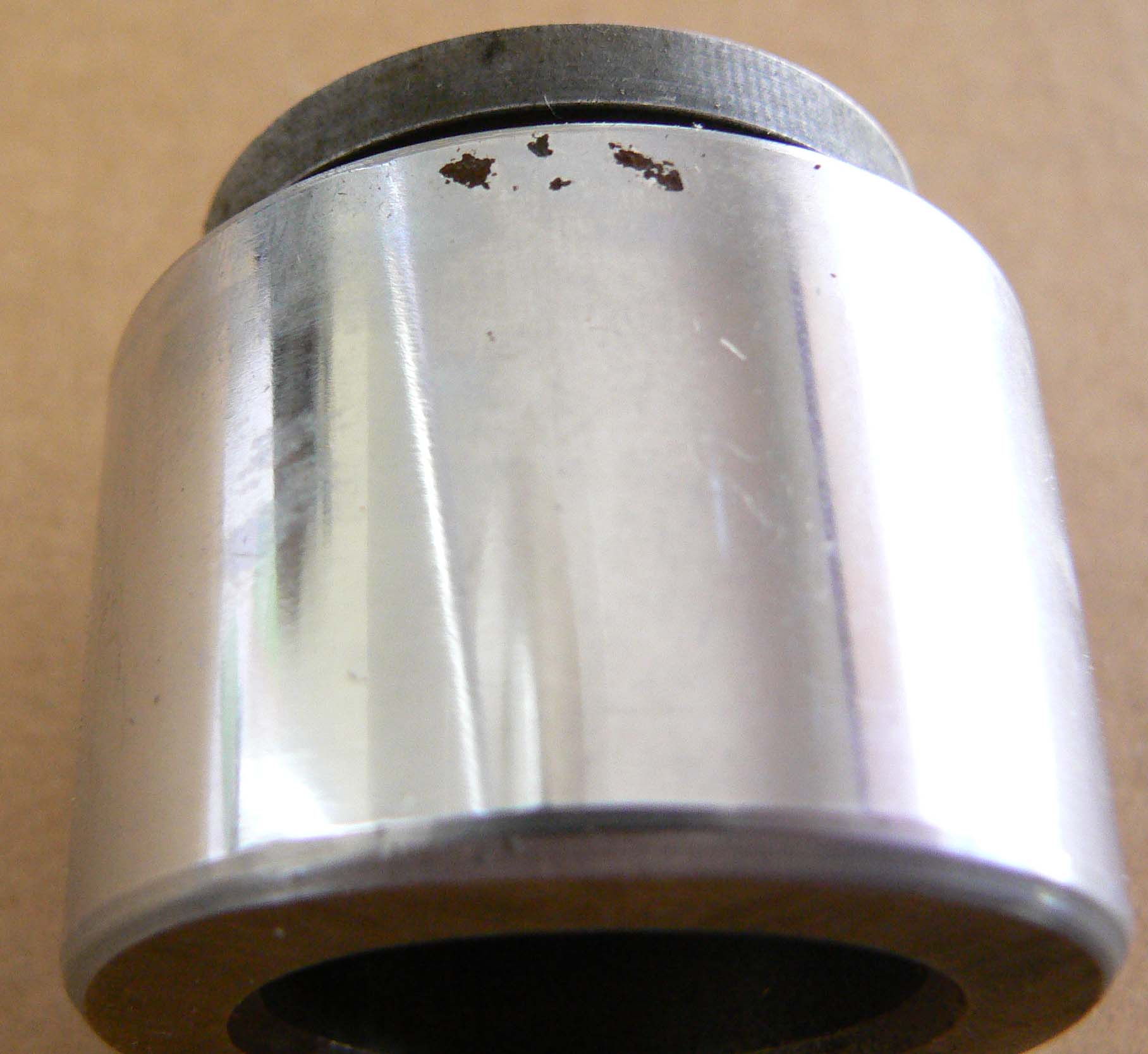
Ate installed chrome-plated steel pistons in the brake calipers used on BMW airhead motorcycles. What could go wrong? Take a look at the Hall of Shame below and decide for yourself. Since brake fluid absorbs water and water rusts steel, for the most part it is just a question of when an Ate piston will develop pitting requiring its replacement. BMW will happily sell you another chrome-plated steel piston to replace the failed one, but of course the new one will eventually succumb to the same fate as the original.
The alternative is pistons made of stainless steel. We extensively tested these for heat expansion, compatibility and functionality, and have been using them ourselves for over four years. They are CNC machined, center ground and polished, all in America, from T303 stainless. Is there a downside? Only one that we know of, and that is an increase in weight (a 40mm SS piston weighs 21 grams more than an OEM piston). Available in 38mm and 40mm sizes, $55.00 each ppd to USA address. Please use contact info below if interested.
I use silicone in my "vintage" machines, both cars and bikes. Daily drivers get the fluid specified in the owner's manual. Many respected authorities insist that using silicone is verboten (see, for example, Robert Fleischer's imprecation at http://www.bmwmotorcycletech.info/brakes.htm), so what follows may be controversial, wrong or just one old guy's opinion. But it is based on a lot of study, and experience with silicone (well over two decades' worth) in a lot of machines, and not on one installation done last weekend.
Why silicone? Two reasons, really. Since it isn't hygroscopic (moisture-absorbing) you have a better chance that steel brake parts won't rust, especially the master cylinder. This is particularly useful if fluid isn't changed regularly (every year or two, depending on climate) or the bike isn't regularly ridden. And silicone fluid, if/when it gets loose, won't destroy paint. DOT4 is an excellent paint remover. I like keeping the paint on my bikes nice. To me, that's worth a few compromises.What about the disadvantages? One disadvantage I haven't run into is seal incompatibility with Ate and Girling brakes; and so far, the Brembos have also been OK (only have about ten years on those, though). However, bleeding silicone fluid can be a PITA. This is because it is more viscous than glycol, and tends to trap tiny bubbles. It can (but usually doesn't) take multiple bleeding sessions over a number of days to be fully satisfactory, as the bubbles slowly work themselves to the high point. You also may need to resort to alternative bleeding methods (Vacula is my standard bleeding tool, but sometimes it doesn't work well when introducing silicone). I haven't yet seen a system that couldn't be bled, but occasionally patience is tested. Often, letting it sit for a day and coming back works wonders. Another rap on silicone is lever/pedal feel. This is a legitimate complaint. Silicone molecules are a bit more compressible than glycol molecules, so they net a somewhat spongier feel. It doesn't bother me much, but it may bother you. Something I've experienced multiple times, but for which I've never seen an explanation, is the effect of altitude. At high altitudes (esp. over 6000 feet) the brakes get spongier, becoming uncomfortably so over 8000 feet. If you regularly ride over the Sierras or Beartooth Pass, this is a good reason to avoid silicone. Silicone has a higher boiling point than DOT4, but for Airhead riding you should never get close to boiling either of them, so I don't consider this a selling point.
Even with silicone, water can still collect in the brake system, condensing out of the air (but this will be a lot less water than DOT4 absorbs). Since water is heavier than silicone brake fluid, it tends to collect at the low point in the calipers. For the same reason, bleeding may not flush water out of the calipers, as the lighter air and fluid head to the top, leaving any water present at the bottom. It is ironic that glycol's ability to absorb water is an advantage when bleeding to remove moisture, while at the same time its affinity for moisture mandates the bleeding in the first place. So, what to do if using silicone fluid? You could take off the caliper and bleed it while holding it upside down (put a spacer between the brake pads first), so the bleeder is the low point. Just give the water a few minutes to migrate down (it moves through silicone fairly quickly) before cracking the nipple. Or, the brake piston could be popped out, the caliper cavity cleaned, followed by reassembly and bleeding. This is what I do. A schedule for either might be every 3-5 years. Water accretes in a silicone system very slowly, but I've seen it cause brake piston problems (fairly mild compared to DOT4) after 15-20 years without water purging measures. With stainless steel pistons, the concern is the caliper corroding, not the piston. In an extreme case I suppose the accumulated water could water could boil causing loss of braking ability (same as with DOT4), but since stainless transfers heat much less effectively than iron or steel, you'd have to really work at it. The risk is theoretical; I've never seen stainless pistons boil accumulated water (wish I could say the same about chromed steel pistons and DOT3).
Literature suggests that silicone and DOT4 can coexist, but I don't recommend it, if for no other reason than you'd still have hygroscopic fluid in the system. Generally the best time to change to silicone is after a brake system overhaul. And don't forget the brake lines -- blow them out (when disconnected) with compressed air, getting out as much of the old fluid as you can. I've even run solvent through steel lines to get all the glycol out, followed by repeatedly blowing through filtered compressed air and allowing time for evaporation.
There were a number of Ate under-tank master cylinders used by BMW, and they are just different enough that most parts don't interchange. Oh, those crafty Germans.
I've been seeing more and more master cylinders with severe corrosion in the bores. This is, of course, caused by moisture in the system. Proper maintenance makes a big difference, but in humid environments it seems to be a matter of when, and not whether, corrosion strikes. In an ideal world, the master cylinders would have been cast in stainless instead of iron; it would have been well worth the incremental cost. But perhaps it is unreasonable to expect more than 30-40 years out of a hydraulic casting.
If the corrosion is bad enough to affect sealing, repairs must be made, right now. This isn't optional. The brakes are all that stand between you and oblivion. If you can't afford to fix this properly, park or sell the bike.
The good news is, new master cylinders are still available. The bad news is, they ain't cheap. Street price is about $380 as this is written (2014).
The alternative is sleeving the existing cylinder. This is done by boring out the cylinder and installing a tube of correct dimensions, and drilling holes in the tube for fluid access. The best material for this is stainless steel, and the most common is brass. Is brass better than the original cast iron? I really don't know, and wouldn't even if the exact brass alloy used was disclosed -- but I suspect that brass is less susceptible to corrosion and more susceptible to mechanical wear than cast iron. Since corrosion is more of an issue than abrasion, my guess is that brass is better than iron, but that's just a guess. Actually knowing the answer might tip the choice between replacement and sleeving.
Some local machine shops do sleeving, but setup is generally too time-consuming to be profitable unless sleeving is core service. Two companies I know of have a regular turnover of Airhead master cylinders:
I used White Post for the last master cylinder I had sleeved. Cost with shipping (May 2014) was $145, and they used a brass sleeve. They also sand blasted the outside of the cylinder (good) removing the cadmium from the actuating lever (bad) and painted everything with an iron-colored grey paint (I'd rather they used the original black - I masked it and added a black coat). The Ate rebuild kit was about $76, so the sleeved rebuild saved a bit over $150 vs new (after shipping). Turn-around was about 3 weeks. Functionally the resleeve was a complete success.
I haven't used Apple Hydraulics, but their site claims $90 for sleeving with brass, which is a very attractive price. If anyone reading this has used them (or anyone else not mentioned here), please email your experience to me.
We've all seen Ate-era Airhead brake disks develop wear gooves. BMW made the disks from stainless steel, which is a cosmetically nice material but, perhaps, less than ideal from a wear, friction and servicing point of view.
What chews up the disks? Three things come to mind. First, crap caught between the brake pad and the disk. Second, misadjusted calipers -- I've seen rotors worn out on one side due to this. Third, sticking caliper pistons. When the piston can't fully retract, the pad and disk wear out very quickly. Sticking pistons can happen gradually enough that you might not notice. That's what tech days are for -- expose the bike to a fresh set of eyes and hands.
I've tried turning and grinding OEM disks, without success. I haven't tried grinding them after detaching them from the alloy carrier, but at some point I'll get around to it (being austenitic, the stock disk is a PITA to grind).
There are two kinds of disks: (1) those that need replacement, and (2) those that will need replacement if the bike is ridden much or not maintained.
When it comes time to replace disks, I know of four possible routes to go.
Meehanite's disadvantages are (1) it is heavier than stainless, (2) the swept (uncoated) area will rust when disused or wetted, and (3) it doesn't look stock. Its advantages are (1) less expensive, (2) more durable, (3) subjectively the bike seems to stop better, and (4) they are serviceable. By "serviceable" I mean that they are easily removed from the carrier, ground flat and returned to service. I have done this successfully a number of times. Being somewhat finicky, after grinding I have them cadmium plated with the next cad batch, but Marcus can tell you what paint to use if you're less fussy. I use EBC pads with them.
Contact:
sspistons@bikerider.com